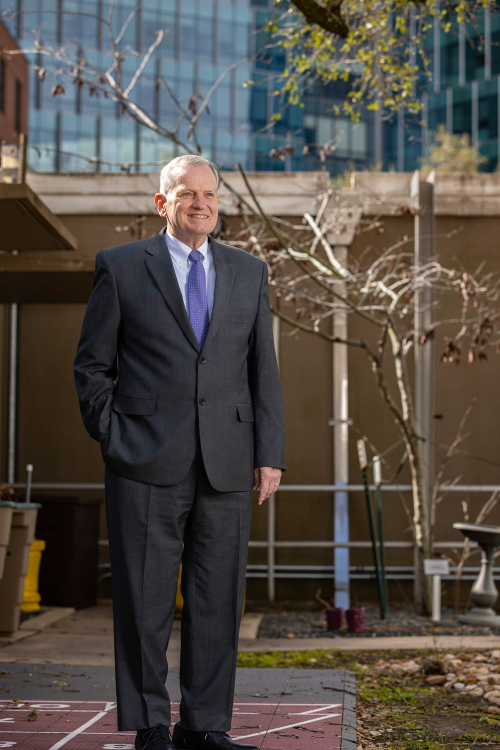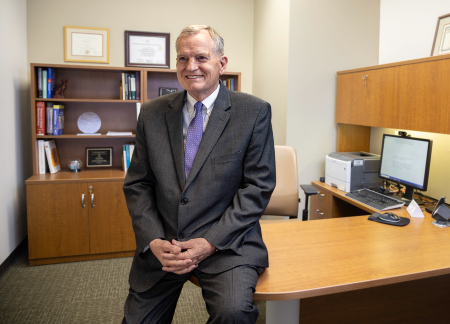 Dr. Mark Sherer has spent his career expanding compassionate, state-of-the-science clinical services for people affected by brain injury, through high-impact contributions to clinical research, program development, education and dissemination.
Dr. Mark Sherer has spent his career expanding compassionate, state-of-the-science clinical services for people affected by brain injury, through high-impact contributions to clinical research, program development, education and dissemination.
Mark Sherer grew up in Tuscumbia, Ala., a few blocks from the home of Helen Keller, which today is a museum. He began his academic career as a math major at a small college that later became the University of North Alabama. Toward the end of his undergraduate years, he developed an interest in sociology and then psychology, graduating with a bachelor’s degree in psychology in 1976. He earned a master’s degree in clinical psychology in 1978 and a doctorate in the same specialty in 1981.
Over the last 40 years, Dr. Sherer has made major contributions to the development of clinical services for people with brain injury and to research applied rapidly to clinical care. Early in his career, after three years in the Department of Psychology at Mississippi State University in Starkville, he and his wife, Connie, moved to Mobile, Ala., where he developed and directed the first community reintegration program for people with brain injury in the Southeast, and one of the first in the United States.
“It was a very early program at a time when there were few interdisciplinary post-acute rehabilitation programs in the U.S., and we had a lot of success returning people with brain injury to work and the community,” he says. “Many of these people did not have a lot of activity outside the home, placing a huge burden on the family. We saw that when we could help them return to work, the quality of their lives improved. They could develop other relationships, which lightened the family burden of support. They also developed a satisfying sense of self by providing value to the people around them. The return to work was important for them in practical terms, but it was also important symbolically, because it represented a return to normalcy.”
In developing his program in Alabama, Dr. Sherer joined Yehuda Ben-Yishay, PhD, a psychologist whose experience working with wounded Israeli soldiers led to pioneering advances in treating traumatic brain injury, and George Prigatano, PhD, emeritus chair of the Department of Neuropsychology at Barrow Neurological Institute, known for his study of impaired awareness as reflected in anosognosia, in leading the field in the development of post-acute rehabilitation services for individuals with brain injury. Although considerable progress had been made in developing methods of physical rehabilitation by the 1980s, methods to address cognitive and behavioral disabilities after brain injury were largely undeveloped. A handful of programs like Dr. Sherer’s became the living laboratories for developing more specific methods for addressing these issues.
After five years of accomplishment in Mobile, Dr. Sherer recognized that his lack of specialized training in neuropsychology was preventing him from doing research that would have a more far-reaching impact. “I had been out of school for eight years. Connie and I took a big chance and a big cut in pay and moved from Mobile to Oklahoma City so I could complete a postdoctoral fellowship in clinical neuropsychology at the University of Oklahoma Health Sciences Center,” he says. “There, I worked with Oscar Parsons, one of the most prominent neuropsychologists in the world at the time, and learned about neuroanatomy, neuropathology, clinical neurology and the signs and symptoms of various neurological disorders.”
During his two years in fellowship, he authored 12 scientific papers, one of many accomplishments of which he is proud. His academic success increased his motivation to go further in the field of brain injury and led to his recruitment in 1991 to TIRR Memorial Hermann (formerly TIRR, The Institute for Rehabilitation and Research) as director of neuropsychology and the Challenge Program. The move also gave him the opportunity to begin working with the Traumatic Brain Injury Model Systems of Care, founded by the National Institute of Disability, Independent Living and Rehabilitation Research in 1987, with TIRR Memorial Hermann as one of the original sites.
During his first decade at TIRR Memorial Hermann, Dr. Sherer continued as a leader in the field of post-acute brain injury rehabilitation in his clinical work with the Challenge Program. Under his direction, the Challenge Program overtook a similar program in Houston to become one of the largest such programs in the country, treating more than 200 patients a year.
“We had a really strong staff and a strong assistant director, and I had a real passion for the work that came from the time I had spent in Mobile watching lives transform when we could return them to work,” he says.
His work with the Challenge Program and with TIRR Memorial Hermann’s TBI Model System led him to begin research in impaired self-awareness after brain injury, resulting in the Awareness Questionnaire1 used around the world to measure the degree of impairment in accurate self-awareness in brain injury patients. It also led to a peer-reviewed article on return to employment,2 one of his most frequently cited. His work on impaired awareness after brain injury helped build his reputation and increased knowledge of his contributions to rehabilitation nationally and internationally.

At TIRR Memorial Hermann, he also started one of the first postdoctoral training programs based in neurorehabilitation, in collaboration with Corwin Boake, PhD, an adjunct associate professor of physical medicine and rehabilitation at Baylor College of Medicine.
In 1997, Dr. Sherer accepted the position of director of neuropsychology and chair of the research council at Methodist Rehabilitation Center in Jackson, Mississippi, and developed the first community reintegration program in Mississippi. At the University of Mississippi, he started a postdoctoral fellowship and helped train numerous people who have gone on to become accomplished professionals in the specialty. He also served as director of the TBI Model System center in Jackson.
While in Mississippi, Dr. Sherer published what he and others consider his second most important contribution to brain injury rehabilitation: the Confusion Assessment Protocol.3 “We noticed that in early recovery after brain injury, patients had a whole constellation of symptoms: memory loss; disturbance in level of arousal, either hypo- or hyper-arousal; restlessness or agitation; cognitive impairment; and psychotic-type symptoms without a true psychotic disorder,” he says. “We focused on this overall syndrome and called it the post-traumatic confusional state. A few years later, we showed that each one of the symptoms had its own impact on the patient’s eventual outcome.”4
The year before that article was published in 2008, Dr. Sherer returned to TIRR Memorial Hermann as the director of research and senior scientist and worked with Gerard Francisco, MD, professor and Wulfe Family Chair in Physical Medicine and Rehabilitation at McGovern Medical School at UTHealth Houston and chief medical officer at TIRR Memorial Hermann. Dr. Francisco cites Dr. Sherer’s work on the post-traumatic confusional state as “a landmark study that had an immediate and significant effect on my clinical practice. Once we recognized that the agitated state was caused by confusion, we began treating patients with other, more effective medications, which had an immediate positive impact on their outcomes. Personally, I thank Mark for his research and insights.”
In 2020, after years of study, Dr. Sherer and his collaborators published the seminal work on the post-traumatic confusional state and its diagnostic criteria,5 which was endorsed by the American Congress of Rehabilitation Medicine as the official case definition. “This was one of the biggest projects of my career and an important contribution to our field. It involved a large number of authors and took us a number of years. We had started publishing papers on the topic in 2005,” he says.
Rhonda Abbott, PT, FTPTA, MBA, FACHE, has worked closely with Dr. Sherer since she assumed the role of senior vice president and chief executive officer of TIRR Memorial Hermann. “Mark has provided much-needed infrastructure support for our diverse research programs, allowing our teams to accomplish many firsts,” she says. “He is a pioneer for our rehabilitation research programs as the only person ever at TIRR Memorial Hermann to serve as associate vice president for research, and his senior scientist background allowed him to create functional foundational policies and procedures that were vital. His desire to advance the work of our research teams has led to alignment around key strategic initiatives. In doing so, he transformed us into a more unified research organization. He truly has left TIRR Memorial Hermann in a better place, and his legacy will carry us forward.”
Among the physician researchers Dr. Sherer has worked with as part of the TBI Model Systems program is Flora Hammond, MD, professor and chair of the Department of Physical Medicine and Rehabilitation at Indiana University School of Medicine. “I did my residency at Baylor College of Medicine and remember meeting Mark during the six months I spent at TIRR Memorial Hermann. Seven or eight years later, we both were funded for TBI Model Systems and started working together,” says Dr. Hammond, who now considers him a dear friend. “In 2008, I was leading a multisite study on the efficacy of amantadine to treat irritability, with Mark as co-investigator. He was the person I would talk through things with. He was always available, calm and supportive, offering advice in a collegial way. He also was always spot on with his expertise and recommendations. He helped make the project fun, productive and successful.
“Part of moving science forward is not just what the study results showed but how you accomplished it,” she adds. “Mark has been a steady contributor to research, with studies that span a range of topics that are important for the care of individuals with brain injury. He’s very collaborative and comes alongside you to work with you. You don’t see that with everyone.”
In the past 40 years, the field of brain injury rehabilitation has gone from little knowledge about how to provide rehabilitation services to people recovering from brain injury to solid evidence-based practices. “My interest was never in identifying the deficits but in how we can return people with brain injury to normal life. Over time, the profession of neuropsychology became more about treatment rather than just assessment,” says Dr. Sherer, who will retire from TIRR Memorial Hermann in 2023. His research in impaired awareness and the post-traumatic confusional state have resulted in assessment protocols used around the world.
Joseph T. Giacino, PhD, is the director of rehabilitation neuropsychology at Spaulding Rehabilitation Hospital, consulting neuropsychologist in the Department of Psychiatry at Massachusetts General Hospital and professor of physical medicine and rehabilitation at Harvard Medical School. He and Dr. Sherer have worked together for more than two decades, first publishing together in 2008 through a Traumatic Brain Injury Model System collaboration.
“I’m built the same way as Mark. I spent years as a clinician and made a slow transition to research,” Dr. Giacino says. “We bonded at our twice annual visits to Washington for the TBI Model Systems project directors meetings, and over the years, we became close friends. Mark has a distinctive conversational style. He’s deliberate and articulate, and he holds your attention. He also has a very dry, saber-sharp wit and can take an idea and spin it very quickly and fluently. He and I very quickly got into a jab fest, which we continue to this day, and he’s always better at it than I am.
“His work on post-traumatic confusional state, built on the work of many people, advanced our field in terms of understanding a really enigmatic clinical syndrome,” Dr. Giacino adds. “At Spaulding, we’re now finishing up our protocol for management of patients in post-traumatic confusional state and much of what we’re doing draws on his work.”
What will Dr. Sherer miss most in retirement? “The people,” he says without pause. “I’ve worked with a lot of patients who have changed my life. I’ve had the opportunity to know them and see the incredible resilience they have in the face of brain injury. All the good research we’ve done has come from these patients and what they’ve taught me.
“I’ll also really miss TIRR Memorial Hermann,” he says. “Most of my career has been at TIRR Memorial Hermann —21 years in two posts and about 22 years by the time I retire. I can see myself extending a little, probably on a part-time basis. I feel enormous gratitude and commitment to TIRR and want to leave it in the best shape I can.”
1Sherer M, Bergloff P, Boake C, High W, Levin E. The Awareness Questionnaire: Factor structure and internal consistency. Brain Injury. 1998;12:63-68.
2Sherer M, Bergloff P, Levin E, High Jr. WM, Oden KE, Nick TG. Impaired awareness and employment outcome after traumatic brain injury. Journal of Head Trauma Rehabilitation. 1998;13(5):52-61.
3Sherer M, Nakase-Thompson R, Yablon SA, Gontkovsky ST. Multidimensional assessment of acute confusion after TBI. Archives of Physical Medicine and Rehabilitation. 2005;86:896-904.
4Sherer M, Yablon SA, Nakase-Richardson R, Nick T. Effect of Severity of Posttraumatic Confusion and Its Constituent Symptoms on Outcome after Traumatic Brain Injury. Archives of Physical Medicine and Rehabilitation. 2008;89:42-47.
5Sherer M, Katz DI, Bodien YG, Arciniegas DB, Block C, Blum S, Doiron M, Frey K, Giacino JT, Graf MJP, Greenwald B, Hammond FM, Kalmar K, Kean J, Kraus MF, Nakase-Richardson R, Pavawalla S, Rosenbaum A, Stuss DT, Yablon SA. The Post-traumatic Confusional State: A Case Definition and Diagnostic Criteria. Archives of Physical Medicine and Rehabilitation. 2020;101:2041-2450.
